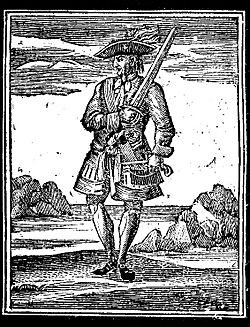Capture of John "Calico Jack" Rackham facts for kids
Quick facts for kids Capture of John "Calico Jack" Rackham |
|||||||
|---|---|---|---|---|---|---|---|
| Part of the Golden Age of Piracy | |||||||
 An 18th-century woodcut of Calico Jack |
|||||||
|
|||||||
| Belligerents | |||||||
| Commanders and leaders | |||||||
| Strength | |||||||
| 1 sloop | 1 sloop | ||||||
| Casualties and losses | |||||||
| None | 13 captured 1 sloop captured |
||||||
The capture of John "Calico Jack" Rackham was a famous event during the Golden Age of Piracy. It involved the well-known pirate Calico Jack and a British ship led by Jonathan Barnet. This important sea battle took place near Negril, Jamaica, and ended with Calico Jack and his crew being captured.
Contents
The Story of Calico Jack
Calico Jack was a pirate captain known for his colorful clothes, which gave him his nickname. He commanded a small but fast ship called the William. This ship was a sloop, a type of sailboat with one mast. It had at least four cannons and a crew of fourteen. Among his crew were two famous women pirates, Mary Read and Anne Bonny.
From Pirate to Pardoned
Calico Jack started his pirate life working for another captain, Charles Vane. But soon, he got his own ship. In 1719, he sailed to New Providence in the Bahamas. He hoped to get a special "King's Pardon." This was a chance for pirates to stop their illegal activities and be forgiven by the King of England.
At that time, England was fighting a war called the War of the Quadruple Alliance. They wanted former pirates to become "privateers." A privateer was like a legal pirate, given permission by the government to attack enemy ships. Calico Jack hoped to get a "letter of marque," which was the official paper allowing him to do this.
A Return to Piracy
Calico Jack did receive a pardon, but he didn't get the job of attacking Spanish ships. He settled in New Providence and met Anne Bonny there. However, when his money ran out, he decided to go back to being a pirate. On August 22, 1719, Rackham and eight other men stole the sloop William from Nassau harbor and sailed away.
The Hunt Begins
The Governor of Jamaica, Nicholas Lawes, decided to send someone to catch Calico Jack. He chose Captain Jonathan Barnet for this mission. Barnet took two sloops with him. One ship, the Snow-Tyger, was strong and had many guns. It carried about twenty sailors from the Royal Navy and some soldiers.
The other ship was the Mary Anne, led by a former pirate named Jean Bonadvis. Bonadvis's ship had about twenty men. It was Bonadvis who first spotted Calico Jack's ship. He fired at Rackham, but then pulled back to tell Barnet where the pirates were. Bonadvis did not join the main fight.
The Capture of Rackham
Around October 31, 1720, Calico Jack's sloop was anchored near Negril. They fired a cannon, which got the attention of Jean Bonadvis's ship. Bonadvis quickly told Captain Barnet. Barnet then sailed his ship to investigate the pirate sloop.
At 10 PM, Barnet called out to the ship, asking who they were. The reply came back: "John Rackham from Cuba." Barnet immediately ordered them to surrender. Someone on Rackham's ship fired a small cannon at Barnet's sloop. Barnet then ordered his ship to fire all its cannons at once. This powerful attack damaged Rackham's ship, breaking its main sail support.
After this, Rackham's crew quickly called for mercy, meaning they wanted to surrender. Barnet then took the captured pirates ashore at Davis's Cove, near Lucea. There, a military officer named Major Richard James arrested them.
What Happened Next
Rackham and his crew were taken to Spanish Town, Jamaica, in November 1720. They faced serious consequences for their piracy and were sentenced to be hanged. Calico Jack was put on display at Rackham's Cay, which was at the entrance of Port Royal. This was done as a warning to other pirates. The bodies of the other pirates were also displayed in different places around the port.
Mary Read and Anne Bonny, the two women pirates, avoided being hanged because they said they were pregnant. Mary Read sadly passed away a few months later before her scheduled punishment. Anne Bonny was never heard from again. Some stories say she retired and lived in North America, while others claim she went back to being a pirate.

